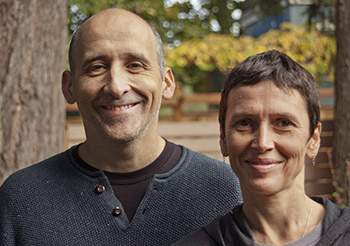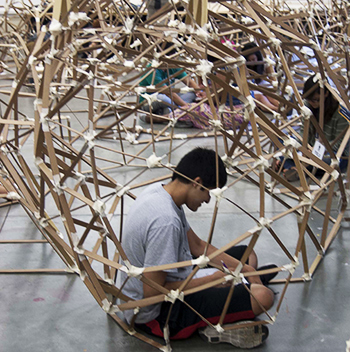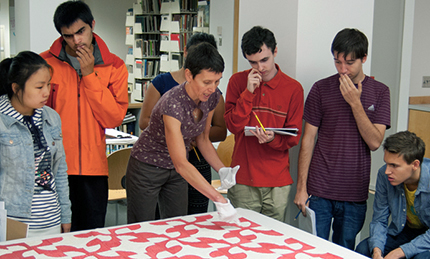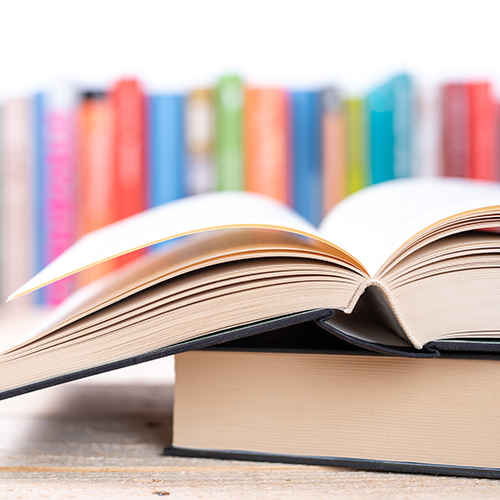Sándor Kovács is a mathematician. Timea Tihanyi is an artist. Their disciplines may seem worlds apart, but the couple—married for 21 years—have found commonalities in their creative process. They share their perspectives in a seminar for freshmen, Left Brain, Right Brain: Creative Thinking in the Sciences & in the Arts, that encourages experimentation and outside-the-box thinking.
“When people hear that Timea is an artist and I’m a mathematician, the response is often, “Ah, opposites attract,’” says Kovács, Craig McKibben and Sarah Merner Endowed Professor in Mathematics. “But Timea and I find that we work similarly. The problems we are trying to solve are very different, and we would probably use different words to define creativity, but the creative process is similar. We decided to go out and tell the world what that really means for us.”

The pair welcomed the opportunity to teach collaboratively, exploring topics they have discussed around the dinner table for years. The Discovery Seminar format—an immersive month-long course for entering freshmen, offered just before autumn quarter—seemed a perfect fit.
“The students are right out of high school, so this was a big change for them,” says Tihanyi, lecturer in the School of Art + Art History + Design. “Right in the first week, they usually tell us, ‘This course is so completely different than everything that came before.’ They come in thinking that math is about formulas and getting the right result. We ask them to demonstrate how they work through a problem. That’s really new to a lot of them.”
Each week, the class focuses on a different mathematical concept, exploring it through hands-on projects that meld math and art. Kovács and Tihanyi guide the students through a series of steps they find essential to their own creative process. “Creativity is not about coming up with one brilliant idea but the steps one takes to reach it,” says Tihanyi. The process begins with formulation of a question, followed by researching possible solutions, allowing those ideas to incubate and generate more ideas, evaluating which ideas are feasible, and finally executing one chosen idea.

The professors don’t spell out those steps for students but integrate them into the class. One week, for example, they discussArchimedean solids, a geometry concept, and then use the concept in the creation of geodesic domes. Working in groups of four or five, the students first produce small model domes, then a structure large enough to fit the entire team—a daunting engineering challenge that involves considerable trial and error. Finally each student creates an individual compartment extending from the main pod, sized for a single person. “For that last part, they still work with architectural structure and math, but now we ask that they make their pod unique and sculpturally interesting as well,” says Tihanyi. “It’s fantastic to see all the different solutions.”
Another week, after discussing tessellation (mathematical tiling), the class visits the Henry Art Gallery to view textiles that demonstrate the mathematical concept. While the math is new to some students, the gallery experience is equally unfamiliar. “For many students, to see actual objects and not an image of the object is a pretty big deal—so much so that you almost have to tell them how to look at something, how to look at the details,” says Tihanyi. After studying the textiles, the students head to the art studio to design banners of their own that incorporate tessellations.
Now, everything I look at I ask myself where was the math involved, and where did they make an artistic choice—even if they didn’t know it was an artistic choice.
Kovács and Tihanyi have taught the discovery seminar twice, with 24 students in each class. The first year, half the students were interested in science, the other half art. This year the vast majority identified as science students. One might assume that science students have an advantage given the mathematical underpinnings of the course, but Kovács insists that the math concepts require abstract thinking but not an advanced math background. In fact, he says, the creative process emphasized in class can be a challenge for some students who have previously excelled in math.
“The science-oriented people are more methodical in how they approach things,” Kovács explains. “You give them an assignment and they do their best to complete it, but they don’t necessarily allow themselves to be free. Part of what we do in class is try to awaken their ‘freeness,’ because even in science you can’t be very creative unless you let yourself fly.”

Alex Compeau, a freshman interested in math and engineering, says he was “inspired to the core” by the course. “Our schooling has always taught, and still teaches, that art and math don’t mix,” says Compeau. “You either focus on one or the other. It’s crazy, because the two are so linked together. Now, everything I look at I ask myself where was the math involved, and where did they make an artistic choice—even if they didn’t know it was an artistic choice.”
Compeau’s comments hearten Kovács and Tihanyi, whose overarching goal for the course has always been to encourage curiosity and openmindedness. “That’s so important for success in any area,” says Tihanyi. “It doesn’t matter what field it is.”
Compeau intends to pursue a career in engineering, and is convinced that the discovery seminar will influence how he approaches his work. “To be a great engineer, I need to be a great artist as well,” he says. “The class changed the way I see the world around me. It will forever influence me in what I choose to do in my life. I will always remember this class.”
More Stories

Two Majors, Complementary Skills
Elizabeth Xiong (2024), a double major in art history and computer science, shares how she gained different and complementary skills from each major.

Exploring Connections Through Global Literary Studies
The UW's new Global Literary Studies major encourages students to explore literary traditions from around the globe and all eras of human history.

What the Sky Teaches Us
Brittany Kamai, an astrophysicist with knowledge of Pacific Islanders' Indigenous navigation using the sky, is teaching a new UW course, Pacific Indigenous Astrophysics.